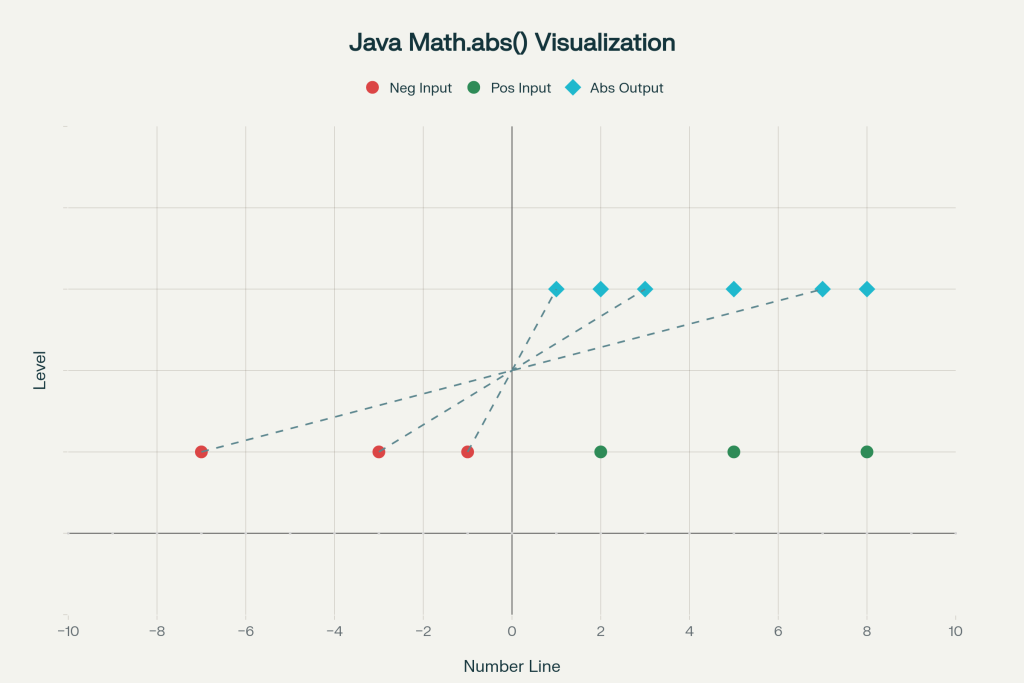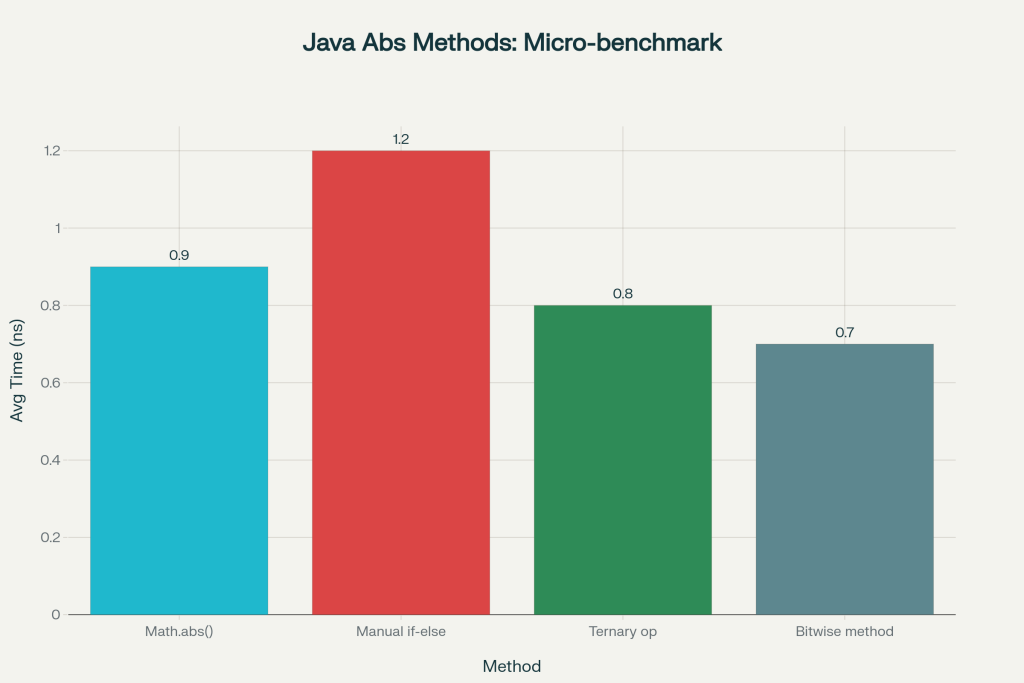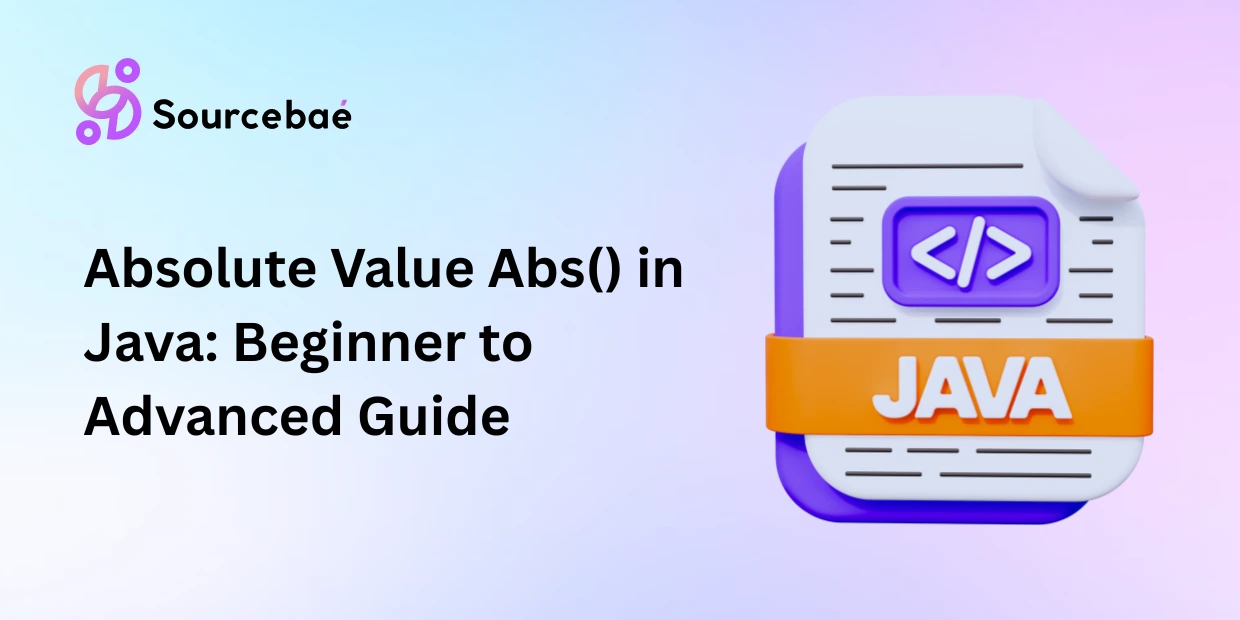The absolute value function is one of the most fundamental mathematical operations in programming, and Java’s Math.abs() method provides developers with a powerful, built-in solution for handling absolute number calculations. Whether you’re calculating distances, processing financial data, or implementing complex algorithms, understanding how to get the absolute value in Java is essential for writing robust and efficient code.
In this comprehensive guide, we’ll explore everything you need to know about Java absolute value operations, from basic syntax to advanced use cases and performance optimization techniques. By the end of this article, you’ll have mastered the Math.abs() function and understand when and how to use it effectively in your Java applications.
Understanding Absolute Value: The Mathematical Foundation
What is an absolute number in mathematical terms? The absolute value of a number represents its distance from zero on the number line, regardless of direction. This concept is crucial because it always produces a non-negative result, making it invaluable for calculations where only positive values make sense.

For example, both -5 and 5 have the same absolute value of 5. Mathematically, this is expressed as |x|, where the vertical bars denote the absolute value operation. In Java programming, this mathematical concept is implemented through the Math.abs() method.
Is absolute value always positive? The answer is yes – absolute values are always non-negative, meaning they can be positive or zero, but never negative. This property makes absolute value calculations essential in scenarios like error analysis, distance calculations, and data validation.
The Java Math.abs() Method: Syntax and Core Functionality
The Java math.abs method belongs to the java.lang.Math class and is designed to handle various numerical data types efficiently. The math import in java is automatically handled since the Math class is part of the java.lang package, which is imported by default.

The general syntax for the absolute function in java follows this pattern:
public static DataType abs(DataType a)
Where DataType can be:
intfor integer valueslongfor long integer valuesfloatfor single-precision floating-point valuesdoublefor double-precision floating-point values
Method Overloading for Different Data Types
The Java math class methods include multiple overloaded versions of abs() to handle different data types:
public static int abs(int a)
public static long abs(long a)
public static float abs(float a)
public static double abs(double a)
This overloading ensures that how to use the math abs function in java remains consistent across all numeric types while maintaining type safety and performance.
Working with Different Data Types: Comprehensive Examples
Integer Absolute Values
Java absolute value operations with integers are the most common use case. Here’s how to implement abs value calculations with integers:
public class IntegerAbsoluteExample {
public static void main(String[] args) {
int negativeNumber = -42;
int positiveNumber = 25;
int absNegative = Math.abs(negativeNumber);
int absPositive = Math.abs(positiveNumber);
System.out.println("Absolute value of " + negativeNumber + " = " + absNegative);
System.out.println("Absolute value of " + positiveNumber + " = " + absPositive);
}
}Output:
Absolute value of -42 = 42
Absolute value of 25 = 25Floating-Point Absolute Values
How to do absolute value with floating-point numbers requires understanding precision considerations:
public class FloatingPointAbsExample {
public static void main(String[] args) {
float floatValue = -3.14159f;
double doubleValue = -123.456789;
float absFloat = Math.abs(floatValue);
double absDouble = Math.abs(doubleValue);
System.out.printf("Absolute value of %.5f = %.5f%n", floatValue, absFloat);
System.out.printf("Absolute value of %.6f = %.6f%n", doubleValue, absDouble);
}
}Long Integer Handling
For absolute value of integers that exceed the standard int range, Java provides Math.abs(long):
long largeNegative = -9876543210L;
long absoluteLarge = Math.abs(largeNegative);
System.out.println("Large number absolute value: " + absoluteLarge);Edge Cases and Critical Considerations
Integer.MIN_VALUE Overflow Issue
One of the most important absolute value java edge cases involves Integer.MIN_VALUE. Due to the asymmetric range of signed integers, taking the absolute value of the most negative integer results in overflow:
public class EdgeCaseExample {
public static void main(String[] args) {
int minValue = Integer.MIN_VALUE; // -2,147,483,648
int result = Math.abs(minValue); // Still -2,147,483,648!
System.out.println("Integer.MIN_VALUE: " + minValue);
System.out.println("Math.abs(Integer.MIN_VALUE): " + result);
System.out.println("Still negative: " + (result < 0));
}
}This occurs because the positive range of int only goes up to 2,147,483,647, while the negative range goes down to -2,147,483,648.
Special Floating-Point Values
What does math.abs do with special floating-point values?
Math.abs(Double.NaN)returnsNaNMath.abs(Double.POSITIVE_INFINITY)returnsPOSITIVE_INFINITYMath.abs(Double.NEGATIVE_INFINITY)returnsPOSITIVE_INFINITYMath.abs(0.0)andMath.abs(-0.0)both return0.0
Performance Analysis and Optimization
Benchmarking Different Approaches

Performance testing reveals interesting insights about math abs java implementation compared to manual alternatives:
The math.abs method performs competitively with manual implementations while providing better readability and maintenance. Java programming math functions are optimized at the JVM level, often resulting in single machine code instructions.
When to Use Alternatives
For absolute value of -4 and similar simple cases, the built-in Math.abs() method is recommended. However, in extremely performance-critical scenarios, manual bitwise operations might provide marginal improvements:
// Bitwise absolute value (for advanced use cases only)
public static int bitwiseAbs(int value) {
int mask = value >> 31;
return (value + mask) ^ mask;
}Real-World Applications and Use Cases
Distance Calculations
How to find the absolute value of a number is crucial for distance calculations in 2D/3D space:
public class DistanceCalculator {
public static double manhattanDistance(int x1, int y1, int x2, int y2) {
return Math.abs(x2 - x1) + Math.abs(y2 - y1);
}
public static void main(String[] args) {
int distance = (int) manhattanDistance(0, 0, 3, 4);
System.out.println("Manhattan distance: " + distance);
}
}Error Tolerance Checking
Absolute value in java is essential for implementing error tolerance in numerical computations:
public class ErrorToleranceChecker {
private static final double TOLERANCE = 0.001;
public static boolean isWithinTolerance(double expected, double actual) {
return Math.abs(expected - actual) <= TOLERANCE;
}
}Financial Calculations
Absolute number operations are critical in financial applications for calculating price differences and profit/loss margins:
public class FinancialCalculator {
public static double calculatePriceDifference(double price1, double price2) {
return Math.abs(price1 - price2);
}
public static double calculateProfitLoss(double buyPrice, double sellPrice) {
double difference = sellPrice - buyPrice;
return difference; // Keep sign for profit/loss indication
}
public static double calculateAbsoluteProfitLoss(double buyPrice, double sellPrice) {
return Math.abs(sellPrice - buyPrice); // Absolute magnitude only
}
}Advanced Implementation Techniques
Custom Absolute Value Calculator Classes
Building reusable absolute function java implementations enhances code organization and maintainability:
public class AbsoluteValueCalculator {
// Generic method using Number class
public static <T extends Number & Comparable<T>> double calculateAbsolute(T number) {
return Math.abs(number.doubleValue());
}
// Specialized method for integer arrays
public static int[] getAbsoluteArray(int[] numbers) {
int[] result = new int[numbers.length];
for (int i = 0; i < numbers.length; i++) {
result[i] = Math.abs(numbers[i]);
}
return result;
}
// Method with overflow protection
public static long safeIntegerAbs(int value) {
return Math.abs((long) value);
}
}Integration with Stream API
Modern Java math absolute operations can be elegantly combined with Stream API for functional programming approaches:
import java.util.Arrays;
import java.util.List;
import java.util.stream.Collectors;
public class StreamAbsoluteExample {
public static void main(String[] args) {
List<Integer> numbers = Arrays.asList(-5, 3, -8, 0, 7, -2);
List<Integer> absoluteValues = numbers.stream()
.map(Math::abs)
.collect(Collectors.toList());
System.out.println("Original: " + numbers);
System.out.println("Absolute: " + absoluteValues);
}
}Best Practices and Development Guidelines
Error Handling and Validation
Implement robust error handling when working with absolute value js concepts translated to Java:
public class SafeAbsoluteCalculator {
public static OptionalDouble safeAbsolute(String input) {
try {
double value = Double.parseDouble(input);
if (Double.isNaN(value)) {
return OptionalDouble.empty();
}
return OptionalDouble.of(Math.abs(value));
} catch (NumberFormatException e) {
return OptionalDouble.empty();
}
}
}Documentation and Code Comments
Always document edge cases and assumptions when implementing absolute value in java:
/**
* Calculates absolute value with overflow protection
* @param value Input integer value
* @return Absolute value as long to prevent overflow
* @throws IllegalArgumentException if value is Integer.MIN_VALUE
*/
public static long protectedAbs(int value) {
if (value == Integer.MIN_VALUE) {
throw new IllegalArgumentException("Cannot safely compute absolute value of Integer.MIN_VALUE");
}
return Math.abs(value);
}Testing Strategies
Comprehensive testing should cover what is the absolute value of -4 and similar edge cases:
@Test
public void testAbsoluteValueEdgeCases() {
// Standard cases
assertEquals(4, Math.abs(-4));
assertEquals(4, Math.abs(4));
assertEquals(0, Math.abs(0));
// Edge cases
assertEquals(Integer.MIN_VALUE, Math.abs(Integer.MIN_VALUE)); // Overflow case
assertTrue(Double.isNaN(Math.abs(Double.NaN)));
assertEquals(Double.POSITIVE_INFINITY, Math.abs(Double.NEGATIVE_INFINITY));
}Performance Optimization and Memory Considerations
JVM Optimization Benefits
The class java math implementation leverages JVM optimizations that often compile Math.abs() calls into single CPU instructions. This makes how to import math in java and use the built-in functions more efficient than custom implementations in most scenarios.
Memory-Efficient Batch Operations
For large datasets requiring absolute value of integers, consider batch processing approaches:
public class BatchAbsoluteProcessor {
public static void processInPlace(int[] array) {
for (int i = 0; i < array.length; i++) {
// Handle overflow protection
if (array[i] == Integer.MIN_VALUE) {
throw new ArithmeticException("Overflow risk at index " + i);
}
array[i] = Math.abs(array[i]);
}
}
public static int[] processWithCopy(int[] array) {
return Arrays.stream(array)
.map(Math::abs)
.toArray();
}
}Integration with Popular Java Frameworks
Spring Framework Integration
When working with Spring applications, absolute value in c language concepts translate well to Java service layers:
@Service
public class MathematicalService {
public double calculateDistance(Point2D point1, Point2D point2) {
double deltaX = Math.abs(point2.getX() - point1.getX());
double deltaY = Math.abs(point2.getY() - point1.getY());
return Math.sqrt(deltaX * deltaX + deltaY * deltaY);
}
}Android Development Applications
Java abs methods are frequently used in Android development for UI calculations and sensor data processing:
public class AndroidMathUtils {
public static boolean isSignificantMotion(float currentValue, float previousValue, float threshold) {
return Math.abs(currentValue - previousValue) > threshold;
}
}Comparison with Other Programming Languages
JavaScript Math.abs() Similarities
How to do absolute value js shares conceptual similarities with Java, but with different type handling. Understanding these differences helps developers working in multiple languages:

Python Math Absolute Value
Python math absolute value using abs() function provides similar functionality but with different syntax. Java developers transitioning between languages should note these differences:
// Java
int result = Math.abs(-5);
// Python equivalent: result = abs(-5)
// JavaScript equivalent: result = Math.abs(-5);Troubleshooting Common Issues
Compilation Errors
Function ‘abs’ could not be resolved errors typically occur when developers forget the Math. prefix:
// Incorrect - will cause compilation error
int result = abs(-5);
// Correct - explicit class reference
int result = Math.abs(-5);
// Alternative - static import (less common)
import static java.lang.Math.abs;
// Then: int result = abs(-5);Runtime Considerations
What does math.abs do in terms of runtime behavior includes these considerations:
- No exceptions thrown for normal values
- Overflow behavior with extreme values
- Special handling of floating-point edge cases
- Performance characteristics in tight loops
Conclusion
Understanding how to get absolute value in Java through the Math.abs() method is fundamental for effective Java programming. This comprehensive guide has covered everything from basic abs mathematics concepts to advanced implementation techniques, performance optimization, and real-world applications.
Key takeaways for mastering Java absolute value operations include:
- Math.abs() provides type-safe, optimized absolute value calculations for all numeric types
- Edge cases like
Integer.MIN_VALUErequire special consideration to prevent overflow issues - Performance testing shows math abs java implementations are highly optimized by the JVM
- Real-world applications span from distance calculation to financial calculations and error tolerance checking
- Best practices include proper error handling, comprehensive testing, and understanding overflow scenarios
Whether you’re implementing basic mathematical operations, building complex algorithms, or developing enterprise applications, absolute value java operations using Math.abs() provide a reliable, efficient foundation for your numerical computations. The method’s integration with modern Java features like Stream API and its consistent behavior across different data types make it an indispensable tool in every Java developer’s toolkit.
By following the guidelines, examples, and best practices outlined in this comprehensive guide, you’ll be well-equipped to leverage Java math absolute functions effectively in your applications while avoiding common pitfalls and maximizing performance.





